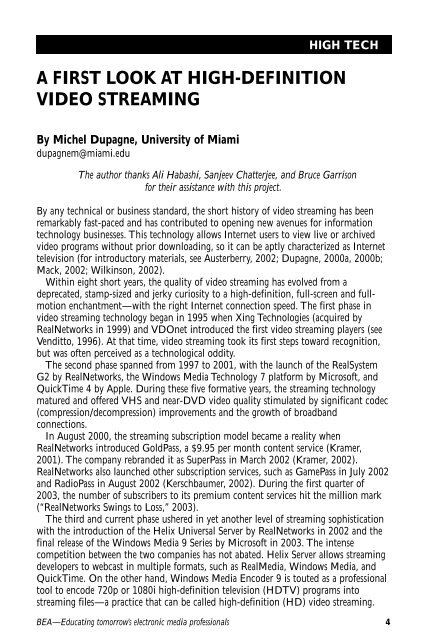HIGH TECHA FIRST LOOK AT HIGH-DEFINITIONVIDEO STREAMINGBy Michel Dupagne, University of Miamidupagnem@miami.eduThe author thanks Ali Habashi, Sanjeev Chatterjee, and Bruce Garrisonfor their assistance with this project.By any technical or business standard, the short history of video streaming has beenremarkably fast-paced and has contributed to opening new avenues for informationtechnology businesses. This technology allows Internet users to view live or archivedvideo programs without prior downloading, so it can be aptly characterized as Internettelevision (for introductory materials, see Austerberry, 2002; Dupagne, 2000a, 2000b;Mack, 2002; Wilkinson, 2002).Within eight short years, the quality of video streaming has evolved from adeprecated, stamp-sized and jerky curiosity to a high-definition, full-screen and fullmotionenchantment—with the right Internet connection speed. The first phase invideo streaming technology began in 1995 when Xing Technologies (acquired byRealNetworks in 1999) and VDOnet introduced the first video streaming players (seeVenditto, 1996). At that time, video streaming took its first steps toward recognition,but was often perceived as a technological oddity.The second phase spanned from 1997 to 2001, with the launch of the RealSystemG2 by RealNetworks, the Windows Media Technology 7 platform by Microsoft, andQuickTime 4 by Apple. During these five formative years, the streaming technologymatured and offered VHS and near-DVD video quality stimulated by significant codec(compression/decompression) improvements and the growth of broadbandconnections.In August 2000, the streaming subscription model became a reality whenRealNetworks introduced GoldPass, a $9.95 per month content service (Kramer,2001). The company rebranded it as SuperPass in March 2002 (Kramer, 2002).RealNetworks also launched other subscription services, such as GamePass in July 2002and RadioPass in August 2002 (Kerschbaumer, 2002). During the first quarter of2003, the number of subscribers to its premium content services hit the million mark(“RealNetworks Swings to Loss,” 2003).The third and current phase ushered in yet another level of streaming sophisticationwith the introduction of the Helix Universal Server by RealNetworks in 2002 and thefinal release of the Windows Media 9 Series by Microsoft in 2003. The intensecompetition between the two companies has not abated. Helix Server allows streamingdevelopers to webcast in multiple formats, such as RealMedia, Windows Media, andQuickTime. On the other hand, Windows Media Encoder 9 is touted as a professionaltool to encode 720p or 1080i high-definition television (HDTV) programs intostreaming files—a practice that can be called high-definition (HD) video streaming.BEA—Educating tomorrow’s electronic media professionals 4
With this historical background in mind, this paper will introduce readers to thebasics of HD video streaming technology. It has four goals: (1) to define the concept ofHD video streaming; (2) to describe relatively simple procedures to encode HDTVcontent with RealNetworks’ Helix Producer Plus; (3) to assess subjectively the videoquality of encoded HD streaming clips in playback tests; (4) and to discuss some of thechallenges that developers and users will face with this advanced streaming application.Though purely experimental for the time being, HD video streaming could take videostreaming technology to an entirely new level within the next five years and deservesattention. For educators interested in media convergence, it also offers an opportunityto appreciate the implications of the challenging marriage between HDTV andcomputer technology.What Is HD Video Streaming?This study defines HD video streaming, or simply HD streaming, as the process ofencoding high-definition video into a streaming file and making it available for viewingon a streaming or web server. This definition is purposively broad to account for futuredevelopments. It deserves some clarification, though. First, this definition does notspecify that images be natively produced in an HDTV format (e.g., 720p, 1080i)because upconverters can convert analog NTSC television or digital standard-definitiontelevision (SDTV) sources to digital HDTV output. Some of these HDTVupconverters now cost less than $15,000 (Kerschbaumer, 2003b). In addition, 16 mmor 35 mm film can be easily transferred to an HDTV formatted tape and would offerhigh-resolution and widescreen images without qualifying as a native end-to-end digitalHDTV product.Second, this definition emphasizes the difference between high-resolution and lowresolutionvideo. Current video streaming is technically graded as low resolution, rarelymatching NTSC’s 30 frames per second and often producing pixelated images duringhigh-motion scenes (see Seel & Dupagne, 2002). HD streaming may change thisperception because it can deliver high-resolution images (1920 x 1080 or 1280 x 720)in full screen with the original number of frames per second at 5 Mbps or lower.Third, the term “HD streaming” is preferable to “HDTV streaming” to reflect thenotion that a streaming encoder further compresses the HDTV source by a ratio ofabout 3:1. As such, the HD streaming quality is more accurately described as high-endSDTV. In fact, compression techniques take a new dimension with HD streaming. Forinstance, the size of the output file from the CineWave HD card (Targa format) usedin the tests below totaled 2.4 GB for 25 seconds. This output was then saved as a 600MB QuickTime Video file, that was then converted to a 15 MB RealMedia file at the 5Mbps bit rate. So, in this example, the final compression ratio of HD streaming was160:1. The same reasoning applies to HD streaming encoding of terrestrial HDTVprogramming. For manageable over-the-air transmission, the original HDTV camerapictures are typically compressed by a factor of up to 60:1, using MPEG-2 technology(Dupagne & Seel, 1998). The optimal bit rate of ATSC 8-VSB HDTV transmission ishighly subjective and depends on such factors as the scanning structure, the number offrames per second, the motion of the content, and the use of concurrent SDTVchannels (see Cervenka, 1998). The maximum date rate of the full 6 Mhz digitaltelevision channel is 19.4 Mbps. A full 1080i/30 stream takes about 18 Mbps, but5Feedback June 2003 (Vol. 44, No. 3)
















